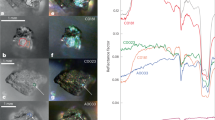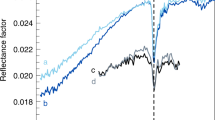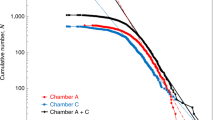Abstract
The samples returned from asteroid Ryugu were collected both at its surface and at its subsurface by Hayabusa2 and can, thus, provide information on the space weathering of C-type asteroids at different depths without terrestrial contamination. The near-infrared hyperspectral microscope MicrOmega gathered data on the –OH feature at ~2.7 μm for 177 individual grains from the two collection sites. Here, through a spectral analysis of these data, we show that the position of the band peak can be used as an indicator of the degree of space weathering. Most subsurficial grains do not present space weathering features, indicating that Ryugu’s subsurface layers have never been exposed to the interplanetary medium. Moreover, the ~2.7 μm feature for the Ryugu samples is narrower than that observed for CI chondrites, which are the closest meteorite analogues to Ryugu, suggesting that these contain more absorbed molecular water than Ryugu due to terrestrial aqueous contamination. We conclude that Ryugu samples should be considered as a reference for the primordial water abundance within primitive bodies.
This is a preview of subscription content, access via your institution
Access options
Access Nature and 54 other Nature Portfolio journals
Get Nature+, our best-value online-access subscription
$29.99 / 30 days
cancel any time
Subscribe to this journal
Receive 12 digital issues and online access to articles
$119.00 per year
only $9.92 per issue
Buy this article
- Purchase on Springer Link
- Instant access to full article PDF
Prices may be subject to local taxes which are calculated during checkout





Similar content being viewed by others
Data availability
The average spectrum of each grain assessed in this study is available from the Ryugu Sample Database System (JAXA) at https://darts.isas.jaxa.jp/curation/hayabusa2/. Source data are provided with this paper.
References
Tachibana, S. et al. Hayabusa2: scientific importance of samples returned from C-type near-Earth asteroid (162173) 1999 JU3. Geochem. J. 48, 571–587 (2014).
Watanabe, S. et al. Hayabusa2 arrives at the carbonaceous asteroid 162173 Ryugu—a spinning top–shaped rubble pile. Science 364, 268–272 (2019).
Kitazato, K. et al. The surface composition of asteroid 162173 Ryugu from Hayabusa2 near-infrared spectroscopy. Science 364, 272–275 (2019).
Lebofsky, L. A. Asteroid 1 Ceres: evidence for water of hydration. Mon. Not. R. Astron. Soc. 182, 17P–21P (1978).
Rivkin, A. S. et al. Hydrogen concentrations on C-class asteroids derived from remote sensing. Meteorit. Planet. Sci. 38, 1383–1398 (2003).
Hamilton, V. E. et al. Evidence for widespread hydrated minerals on asteroid (101955) Bennu. Nat. Astron 3, 332–340 (2019).
Arakawa, M. et al. Scientific objectives of small carry-on impactor (SCI) and deployable camera 3 digital (DCAM3-D): observation of an ejecta curtain and a crater formed on the surface of Ryugu by an artificial high-velocity impact. Space Sci. Rev. 208, 187–212 (2017).
Yada, T. et al. Preliminary analysis of the Hayabusa2 samples returned from C-type asteroid Ryugu. Nat. Astron. 6, 214–220 (2022).
Pilorget, C. et al. First compositional analysis of Ryugu samples by the MicrOmega hyperspectral microscope. Nat. Astron. 6, 221–225 (2022).
Nakamura, E. et al. On the origin and evolution of the asteroid Ryugu: a comprehensive geochemical perspective. Proc. Jpn Acad. Ser. B 98, 227–282 (2022).
Yokoyama, T. et al. Samples returned from the asteroid Ryugu are similar to Ivuna-type carbonaceous meteorites. Science https://doi.org/10.1126/science.abn7850 (2022).
Nakamura, T. et al. Formation and evolution of carbonaceous asteroid Ryugu: direct evidence from returned samples. Science https://doi.org/10.1126/science.abn86 (2022).
Farmer, V. C. in The Infrared Spectra of Minerals (ed. Farmer, V. C.) Ch. 15 (Mineralogical Society, 1974).
Potin, S., Manigand, S., Beck, P., Wolters, C. & Schmitt, B. A model of the 3-μm hydration band with exponentially modified Gaussian (EMG) profiles: application to hydrated chondrites and asteroids. Icarus 343, 113686 (2020).
Bates, H. C., King, A. J., Donaldson Hanna, K. L., Bowles, N. E. & Russell, S. S. Linking mineralogy and spectroscopy of highly aqueously altered CM and CI carbonaceous chondrites in preparation for primitive asteroid sample return. Meteorit. Planet. Sci. 55, 77–101 (2020).
Beck, P. et al. Hydrous mineralogy of CM and CI chondrites from infrared spectroscopy and their relationship with low albedo asteroids. Geochim. Cosmochim. Acta 74, 4881–4892 (2010).
Takir, D. et al. Nature and degree of aqueous alteration in CM and CI carbonaceous chondrites. Meteorit. Planet. Sci.https://doi.org/10.1111/maps.12171 (2013).
Bishop, J. L., Lane, M. D., Dyar, M. D. & Brown, A. J. Reflectance and emission spectroscopy study of four groups of phyllosilicates: smectites, kaolinite-serpentines, chlorites and micas. Clay Miner. 43, 35–54 (2008).
Tomeoka, K. & Buseck, P. R. Matrix mineralogy of the Orgueil CI carbonaceous chondrite. Geochim. Cosmochim. Acta 52, 1627–1640 (1988).
Zolensky, M., Barrett, R. & Browning, L. Mineralogy and composition of matrix and chondrule rims in carbonaceous chondrites. Geochim. Cosmochim. Acta 57, 3123–3148 (1993).
King, A. J., Schofield, P. F., Howard, K. T. & Russell, S. S. Modal mineralogy of CI and CI-like chondrites by X-ray diffraction. Geochim. Cosmochim. Acta 165, 148–160 (2015).
King, A. J., Schofield, P. F. & Russell, S. S. Type 1 aqueous alteration in CM carbonaceous chondrites: implications for the evolution of water-rich asteroids. Meteorit. Planet. Sci. 52, 1197–1215 (2017).
Brunetto, R., Loeffler, M. J., Nesvorný, D., Sasaki, S. & Strazzulla, G. in Asteroids IV (eds Michel, P. et al.) 597–616 (Univ. Arizona Press, 2015).
Chapman, C. R. Space weathering of asteroid surfaces. Annu. Rev. Earth Planet. Sci. 32, 539–567 (2004).
Lantz, C. et al. Ion irradiation of carbonaceous chondrites: a new view of space weathering on primitive asteroids. Icarus 285, 43–57 (2017).
Brunetto, R. et al. Hyperspectral FTIR imaging of irradiated carbonaceous meteorites. Planet. Space Sci. 158, 38–45 (2018).
Thompson, M. S., Loeffler, M. J., Morris, R. V., Keller, L. P. & Christoffersen, R. Spectral and chemical effects of simulated space weathering of the Murchison CM2 carbonaceous chondrite. Icarus 319, 499–511 (2019).
Rubino, S. et al. Space weathering affects the remote near-IR identification of phyllosilicates. Planet. Sci. J. 1, 61 (2020).
Matsuoka, M. et al. Pulse-laser irradiation experiments of Murchison CM2 chondrite for reproducing space weathering on C-type asteroids. Icarus 254, 135–143 (2015).
Laczniak, D. L. et al. Characterizing the spectral, microstructural, and chemical effects of solar wind irradiation on the Murchison carbonaceous chondrite through coordinated analyses. Icarus 364, 114479 (2021).
Noguchi, T. et al. A dehydrated space-weathered skin cloaking the hydrated interior of Ryugu. Nat. Astron. https://doi.org/10.1038/s41550-022-01841-6 (2022).
Nakato, A. et al. Variations of the surface characteristics of Ryugu returned samples. Earth Planets Space. 75, 45 (2023).
Morota, T. et al. Sample collection from asteroid (162173) Ryugu by Hayabusa2: implications for surface evolution. Science 368, 654–659 (2020).
Jaumann, R. et al. Images from the surface of asteroid Ryugu show rocks similar to carbonaceous chondrite meteorites. Science 365, 817–820 (2019).
Okada, T. et al. Highly porous nature of a primitive asteroid revealed by thermal imaging. Nature 579, 518–522 (2020).
Kitazato, K. et al. Thermally altered subsurface material of asteroid (162173) Ryugu. Nat. Astron. 5, 246–250 (2021).
Galiano, A. et al. NIRS3 spectral analysis of the artificial Omusubi-Kororin crater on Ryugu. Mon. Not. R. Astron. Soc. 514, 6173–6182 (2022).
Riu, L. et al. Spectral characterization of the craters of Ryugu as observed by the NIRS3 instrument on-board Hayabusa2. Icarus 357, 114253 (2021).
Takir, D., Stockstill-Cahill, K. R., Hibbitts, C. A. & Nakauchi, Y. 3-μm reflectance spectroscopy of carbonaceous chondrites under asteroid-like conditions. Icarus 333, 243–251 (2019).
Bibring, J.-P., Hamm, V., Pilorget, C. & Vago, J. L., the MicrOmega Team. The MicrOmega investigation onboard ExoMars. Astrobiology 17, 621–626 (2017).
Riu, L. et al. Calibration and performances of the MicrOmega instrument for the characterization of asteroid Ryugu returned samples. Rev. Sci. Instrum. 93, 054503 (2022).
Loizeau, D. et al. Constraints on Solar System early evolution by MicrOmega analysis of Ryugu carbonates. Nat. Astron. https://doi.org/10.1038/s41550-022-01870-1 (2023).
Clark, R. N. & Roush, T. L. Reflectance spectroscopy: quantitative analysis techniques for remote sensing applications. J. Geophys. Res. 89, 6329–6340 (1984).
Milliken, R. E. & Mustard, J. F. Quantifying absolute water content of minerals using near-infrared reflectance spectroscopy. J. Geophys. Res. 110, E12001 (2005).
Milliken, R. E. & Mustard, J. F. Estimating the water content of hydrated minerals using reflectance spectroscopy: I. Effects of darkening agents and low-albedo materials. Icarus 189, 550–573 (2007).
Garenne, A. et al. Bidirectional reflectance spectroscopy of carbonaceous chondrites: implications for water quantification and primary composition. Icarus 264, 172–183 (2016).
Praet, A. et al. Hydrogen abundance estimation model and application to (162173) Ryugu. Astron. Astrophys. 649, L16 (2021).
Press, W. H. & Teukolsky, S. A. Kolmogorov–Smirnov test for two-dimensional data. Comput. Phys. 2, 74 (1988).
Acknowledgements
We thank the whole Hayabusa2 team for their scientific and technical contributions to this successful mission. We thank the National Centre for Space Studies, which is the French space agency, for its support. T.Y. received support from the Japan Society for the Promotion of Science, grant number JP18K03830. We warmly thank P. Beck and D. Takir for providing us with near-infrared spectra of carbonaceous chondrites.
Author information
Authors and Affiliations
Contributions
R.B., C.P., J.-P.B., A.N., V.H., K.H., D.L., L.R., K.Y., T.O., T.Y., T.U., M.A., T.S., S.T., S.N., Y.T. and S.W. conceived and designed the experiments. T.L.P.-J., R.B., C.P., J.-P.B., A.N., K.H., C.L., D.L., L.R., K.Y., T.O., T.Y., Y.H., K.K., A.M., K.N. and M.N. performed the experiments. T.L.P.-J., R.B., C.P., J.-P.B., A.N., C.L., D.L., L.R., D.B., F.P., A.A.-T., J.C. and Y.L. analysed the data. T.L.P.-J., R.B., C.P., A.N., V.H., K.H., C.L., D.L., L.R. and K.Y. contributed materials and analysis tools. T.L.P.-J., R.B., C.P., J.-P.B., A.N., C.L., L.R., D.B., F.P. and T.O. wrote, discussed and commented on the paper.
Corresponding author
Ethics declarations
Competing interests
The authors declare no competing interests.
Peer review
Peer review information
Nature Astronomy thanks the anonymous reviewers for their contribution to the peer review of this work.
Additional information
Publisher’s note Springer Nature remains neutral with regard to jurisdictional claims in published maps and institutional affiliations.
Supplementary information
Supplementary Information
Supplementary Figs. 1–17 and Tables 1–4.
Source data
Source Data Fig. 2
Table of peak positions and band depths for all grains assessed in this study.
Source Data Fig. 4
Table of peak positions and band depths for all grains assessed in this study.
Source Data Fig. 5
Table of peak positions and band depths for all grains assessed in this study.
Rights and permissions
Springer Nature or its licensor (e.g. a society or other partner) holds exclusive rights to this article under a publishing agreement with the author(s) or other rightsholder(s); author self-archiving of the accepted manuscript version of this article is solely governed by the terms of such publishing agreement and applicable law.
About this article
Cite this article
Le Pivert-Jolivet, T., Brunetto, R., Pilorget, C. et al. Space weathering record and pristine state of Ryugu samples from MicrOmega spectral analysis. Nat Astron 7, 1445–1453 (2023). https://doi.org/10.1038/s41550-023-02092-9
Received:
Accepted:
Published:
Issue Date:
DOI: https://doi.org/10.1038/s41550-023-02092-9



